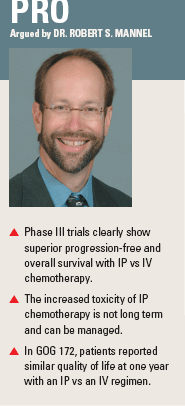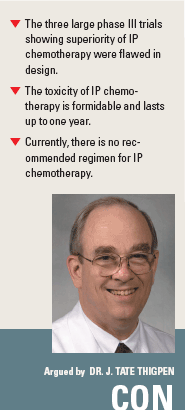Is IP chemotherapy the standard of care for small-volume residual ovarian cancer?
SAN FRANCISCO-The “preponderance of the evidence” supports intraperitoneal chemotherapy as the preferred treatment for small-volume residual ovarian cancer after surgical debulking, Robert S. Mannel, MD, said at a debate session of the 2008 Oncology Congress. J. Tate Thigpen, MD, who took the con side of the debate, argued that IP chemotherapy remains experimental because of flaws in the design of the three major trials of IP therapy and its “formidable toxicity.”
ABSTRACT: At the “pro” speaker’s cancer center, 100% of such patients receive intraperitoneal chemotherapy; at the “con” speaker’s center, only those enrolled in IP therapy clinical trials.
SAN FRANCISCO-The “preponderance of the evidence” supports intraperitoneal chemotherapy as the preferred treatment for small-volume residual ovarian cancer after surgical debulking, Robert S. Mannel, MD, said at a debate session of the 2008 Oncology Congress. J. Tate Thigpen, MD, who took the con side of the debate, argued that IP chemotherapy remains experimental because of flaws in the design of the three major trials of IP therapy and its “formidable toxicity.”
Dr. Mannel, of the University of Oklahoma Health Sciences Center, said that virtually 100% of eligible patients at his center receive IP therapy, with up to 95% getting IP therapy on clinical trials. The rest receive an IP regimen modified from that used in the GOG 172 trial. Dr. Thigpen, of the University of Mississippi Medical Center, said that his center does not use IP therapy outside of clinical trials unless the patient insists.
“Clearly, IP chemotherapy will improve progression-free and overall survival,” Dr. Mannel said. He cited a 21.6% decrease in the risk of death for IP regimens vs IV regimens in an analysis of eight randomized trials, including GOG 172.
“So there is no question about efficacy, but that’s not the question of the debate. The real question is, why is IP therapy not the standard of care,” he said, and what is required for physicians to change their method of practice.
Dr. Mannel pointed to two legal terms used to resolve disputes-preponderance of evidence, used in civil trials, and beyond a reasonable doubt, used in criminal trials. He called the evidence for superior efficacy of IP therapy “beyond reasonable doubt,” but noted that survival alone is not sufficient to change practice patterns; toxicity must also be considered.
For example, GOG 158 showed no difference in survival between cisplatin/ paclitaxel and carboplatin/paclitaxel, but carboplatin is the standard of care because it is less toxic than cisplatin.
GOG 172 showed clear evidence of worse toxicity with IP vs IV therapy. “IP is a more toxic regimen. I am not going to argue with that. But GOG 172 had another component-patient-reported toxicity,” he said.
The researchers used three different quality-of-life assessment tools, measured at four intervals, to determine a total QOL score. Patients reported greater abdominal discomfort, for example, during therapy and three to six weeks after treatment, but at 12 months, abdominal discomfort scores were the same in both arms. “So this toxicity of IP therapy is not long term,” Dr. Mannel said.
Neurotoxicity scores, he said, went up “fairly dramatically” in both arms, but were worse with IP therapy. “But here is the key: At the end of one year, the scores are absolutely the same,” he said. “Patients are okay with it. So the decision to use IP therapy shouldn’t be based on abstract toxicity numbers that are driven by the physician and lab values. It should be driven by the patient.”
Dr. Mannel concluded, based on survival, toxicity, and quality-of-life data, that “the preponderance of the evidence is that IP therapy is better than IV therapy and should be the standard of care.”
Trial designs flawed
Dr. Thigpen countered that the trials favoring IP over IV therapy had other variables in their designs “making definitive conclusions impossible,” and that the trials failed to define a recommended dosing regimen.
In 2006, Dr. Thigpen noted, NCI issued a clinical alert urging physicians to consider IP chemotherapy in optimally debulked ovarian cancer patients, but the agency found it “not possible” to recommend any tested regimen because of the frequent dose adjustments in the trials.
“How can you have a standard of care if you can’t even recommend a regimen?” he asked.
GOG 104 and 114
Dr. Thigpen cited problems with the three large front-line IP therapy studies.GOG 104/SWOG 8501, which compared IV cyclophosphamide/IV cisplatin with IV cyclophosphamide/IP cisplatin, was designed to accrue 400 patients. Midway through the trial, he said, accrual was extended to 650 patients to allow for subset analysis of patients with < 0.5 cm residual disease, who were thought to be most likely to benefit.
The final analysis, which showed a significant survival advantage for IP therapy, was based on all 654 patients, “and that introduced a statistical bias,” he said. Further, there was no significant difference in survival in the subset of 397 patients with < 0.5 cm nodules.
“So not only did we have a flawed analysis on the 654 patients, but we had a counterintuitive result in the patients with < 0.5 cm disease,” Dr. Thigpen said.


The problem with the second study (GOG 114), he said, “is that this is not a comparison of IV therapy vs IP therapy.” In the paclitaxel/IP cisplatin arm, patients received two doses of high-dose carboplatin before IP therapy. “So this is actually the kitchen sink vs IV paclitaxel/ cisplatin,” he said. In addition, the IP cisplatin patients received 100 mg/m2 vs 75 mg/m2 for the IV cisplatin patients.
GOG 172 GOG 172, which showed a significant progression-free and overall survival advantage for IP therapy, used paclitaxel/ cisplatin as a control arm, which was correct at the time the study started, Dr. Thigpen said, but by the time the study finished, carboplatin had become the standard of care based on lower toxicity.
Dr. Thigpen pointed out that GOG 158 showed a nine-month difference in median overall survival favoring paclitaxel/carboplatin vs paclitaxel/cisplatin: “This was right at the margin of being significant, so there wasn’t ‘no difference,’ as Dr. Mannel said, but a nine-month difference that did not quite reach significance.” A carboplatin control arm might have reduced the survival advantage for IP therapy.
In a cross-trial comparison, Dr. Thigpen showed that the improved results with the IP arm in GOG 172 were similar to those achieved in GOG 158 with IV carboplatin/paclitaxel (and in GOG 114 with paclitaxel/IV carboplatin/ IP cisplatin), suggesting that the use of carboplatin may be more important than IP administration.
In addition, the two arms in GOG 172 differed in dosage, with the IP cisplatin patients receiving paclitaxel weekly and 100 mg/m2 of cisplatin per cycle, while the IV arm received paclitaxel every three weeks and 75 mg/m2 of cisplatin. He noted that a Japanese study presented at ASCO 2008 showed a “striking advantage” in survival with weekly vs every-three-week paclitaxel.
Dr. Thigpen also pointed out that in GOG 172, only 59% of patients received the third of six cycles of the IP regimen, and only 42% were able to tolerate all six cycles. Those who stopped IP cisplatin at the third cycle then received IV paclitaxel/ carboplatin, he said, “and we’ve already shown a nine-month median survival gain with paclitaxel/carboplatin vs paclitaxel/cisplatin, so that raises further questions about the survival results.”
In the Q&A session, Dr. Mannel countered that there was crossover in both arms of the study.
Toxicity
Dr. Thigpen noted that the median survival gain for IP therapy in the eight trials cited in the NCI Clinical Alert was 12 months, and that toxicity was increased for 12 months. “Toxicities are formidable, lasting up to 1 year, and require a major commitment to managing the patient,” Dr. Thigpen commented.
He further noted that the increased toxicity of IP therapy in GOG 172 led to dose reductions and early withdrawals. “Reducing doses arbitrarily to avoid toxicity makes no sense,” he said, “because you’re reducing dose intensity, which is supposed to be the thing that gets us the better results, so you’re eliminating any effi cacy advantage.”
In the Q&A session, Dr. Mannel said that the effi cacy of IP therapy “is not a dose-intense phenomenon,” but rather due to changes in the immune environment of the peritoneal cavity and in the host-immune response system.
He also reiterated that his patients tolerate the IP regimen. “We may slow the infusion down, or use heating pads for patients with abdominal discomfort,” he said, adding that chemotherapy toxicity is less a problem than catheter toxicity. “Talk to your patients and provide supportive care, and they’ll get through it,” Dr. Mannel said.
Upcoming trial
An upcoming GOG trial will compare paclitaxel/IV carboplatin vs paclitaxel/ IP carboplatin. “If it’s true that IP is the standard of care, it’s an unethical trial, since IP therapy is not the control,” Dr. Th igpen said.
The new study will employ a modifi ed version of the paclitaxel/IP carboplatin regimen used in GOG 172. “We’re dropping the cisplatin from 100 to 75 mg/m2,” Dr. Mannel said, “and using a three-hour paclitaxel infusion. The trial will also include bevacizumab [Avastin].”
In the meantime, Dr. Thigpen recommends that physicians discuss the potential benefits and toxicity of IP chemotherapy with all patients who have residual disease of 1 cm or less, and if IP therapy is selected, to use the GOG 172 regimen. However, he believes that IP therapy should be reserved for clinical trials “if at all possible.”
Late Hepatic Recurrence From Granulosa Cell Tumor: A Case Report
Granulosa cell tumors exhibit late recurrence and rare hepatic metastasis, emphasizing the need for lifelong surveillance in affected patients.